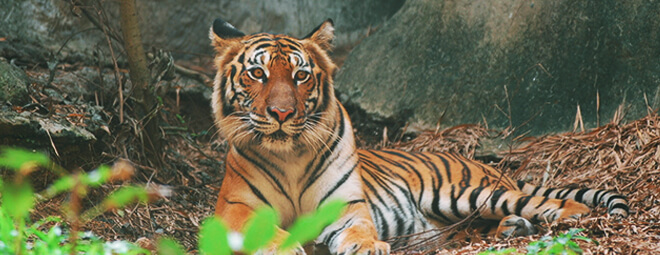ロシアがチョウセンゴヨウ(ベニマツ)伐採を禁止 (仮訳)
2010/11/19
記者発表資料 2010年11月19日
ロシア政府がチョウセンゴヨウの伐採を禁止 アムールトラの重要な生息地保護に大きな一歩
2010年11月21日から24日までロシア、サンクトペテルブルグで開催された「世界トラ保護会議(International Tiger Forum)」の直前、ロシア政府は、禁伐樹種・灌木種リストの改訂を承認し、チョウセンゴヨウがリストに加えられることとなった。
「チョウセンゴヨウの伐採禁止は、アムールトラにとって寅年の最高のプレゼントである。チョウセンゴヨウの実は、イノシシなどトラの捕食動物にとって重要な食料となるため、トラを保護するうえで極めて重要である」とWWFロシアのイゴール・チェスティン(Igor Chestin)は言う。WWFロシアは、トラ保護のためにロシアでとられるべき対策の8大項目の1つとしてチョウセンゴヨウの伐採禁止を挙げ、2010年夏にロシア天然資源・環境省(Ministry of natural resources and environment of Russia)に提出していた。
チョウセンゴヨウを含む「禁伐樹種・灌木種リスト(List of species of trees and shrubs prohibited for timber logging)」の最新版は、2010年8月2日に承認されていた。しかし、これが発効したのは、政府が2007年3月15日に承認した旧リストを無効とした2010年11月12日である。
チョウセンゴヨウの実は、少なくとも50種の生物にとって重要な存在であり、その中にはアムールトラの主な捕食動物である野生のイノシシも含まれる。チョウセンゴヨウの森は、20世紀前半にシホテアリン地方(Sihote-Alin)でアムールトラの個体数がおよそ30頭まで激減した時期の保護活動において重要な役割を果たした。ところが2007年、新しいロシア森林法典(Forest Code of Russia)によりチョウセンゴヨウの商業伐採の禁止が撤廃されたため、チョウセンゴヨウの森は壊滅的といえる打撃を受けた。商業価値のあるチョウセンゴヨウが枯渇しそうな状況にあったことで、林業各社は残っていた利用可能な森、つまり保護林の伐採に殺到した。その結果、2009年にロシア極東から輸出されたチョウセンゴヨウの木材輸出量は史上最大となり、WWFの推計では、その伐採量は許容量の2.5~3.7倍だったと考えられる。
WWFロシア、アムール支部森林プログラムリーダーのデニス・スミルノフ(Denis Smirnov)は、「現在、チョウセンゴヨウの森は、近年で最も悪い状況にある。これまでの半端な対策では、徹底的な伐採からチョウセンゴヨウを救うことはできなかった。地方の林業局と林業各社が自主的に伐採を減らすという計画が大々的に発表されたが、それも社会や政府の問題意識をそらすための中身のない約束に過ぎなかった。このような状況では、チョウセンゴヨウ伐採の全面禁止が、唯一の適切な方法であり、私たちは3年半の間、それを主張し続けてきた」と述べる。
アムールトラに代わりWWFが、ロシア政府及び連邦林業局に、チョウセンゴヨウの森を守る決定に感謝を述べる。
(原文)Russia introduces a ban on Korean Pine logging
The Government of Russia made a giant step to save key habitats of the Amur tiger by banning Korean Pine logging.
Just before the International Tiger Forum, which will take place on November 21-24 in Saint Petersburg, the Russian government adopted a new version of the list of tree and shrub species prohibited for timber logging, and included Korean Pine in the list.
“Ban on Korean pine logging is the best gift for the Amur tiger in the Tiger Year”, says Igor Chestin. “Korean Pine has a crucial importance for tiger conservation: its cones are fodder for wild boars, and wild boars are tiger’s prey”. WWF-Russia included this ban in the list of top 8 measures that must be taken in Russia for tiger conservation, which were presented to the Ministry of natural resources and environment of Russia in summer 2010.
The new version of the “List of species of trees and shrubs prohibited for timber logging”, which includes the Korean Pine, was approved on August 2 2010. However, it came into force only on November 12 2010, when the Government cancelled the previous list, adopted on March 15 2007.
Korean Pine harvest is important for at least 50 species, including the wild boar, one of the main prey species of the Amur tiger. Korean Pine forests played a key role in Amur tiger conservation during the drastic decline in its population (down to just 30 animals) on the Sihote-Alin in the first half of the 20th century. In 2007, Korean Pine forests received an almost mortal blow – the new Forest Code of Russia cancelled the ban on industrial Korean Pine logging. Taking into account that commercially valuable timber stocks are depleting, forest companies rushed to use the remaining available forests – the protection forests. As a result, the largest amount of Korean Pine timber in history was exported from the Russian Far East in 2009, and according to WWF estimations, its harvesting exceeded the allowable limits by 2.5-3.7 times.
“Today, Korean Pine forests are in the worst condition in the recent history”, says Denis Smirnov, head of the Forest Program of WWF-Russia Amur branch. “And half-measures could not save them from complete degradation. Widely announced plans of the regional forest departments and forestries to voluntarily reduce pine logging turned out to be empty promises made to divert the public and government attention from the problem. In this situation, the only adequate decision was to introduce a full ban on Korean Pine logging, and we have been insisting on it for three and a half years”.
WWF from the name of the Amur tiger thanks the Government of Russia and the Federal Forest Agency for saving the Korean Pine.














